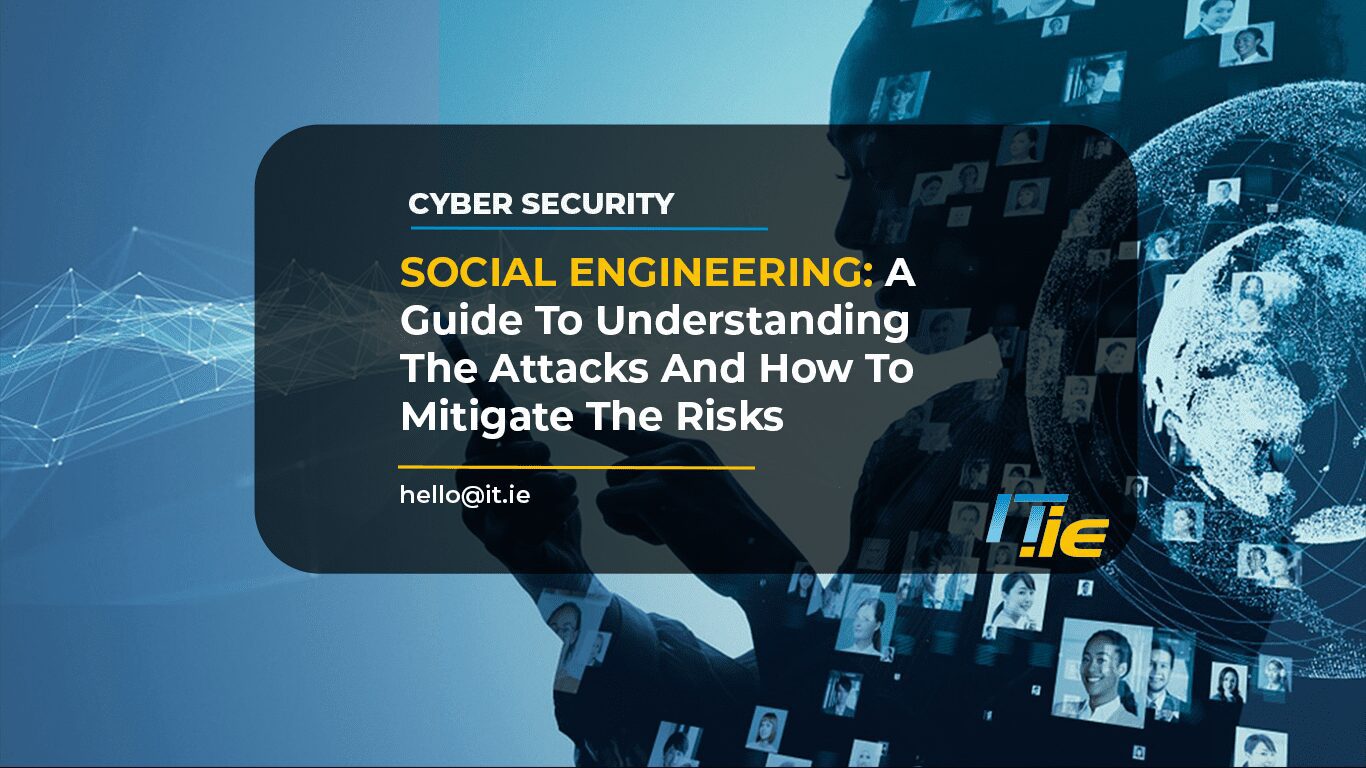Introduction
The landscape of cybersecurity threats is continually evolving and has largely transcended the traditional methods of hacking and virus distribution. Today, social engineering attacks have emerged as one of the most insidious and effective means of attack, relying on manipulation and psychology instead of technical expertise. Modern IT systems are difficult to infiltrate from the outside but not so when you manipulate or trick someone into granting you access. In this guide, we will explore social engineering attacks, the various techniques employed by cybercriminals, and provide practical tips to stay safe from these ever-evolving threats.
Deconstructing Social Engineering

Social Engineering Defined: Social engineering is the act of manipulating individuals into divulging confidential information or performing actions that compromise their security. Cybercriminals accomplish this by exploiting human psychology, making this type of attack particularly challenging to detect.
The Human Factor in Cybersecurity: When it comes to cybersecurity, human error or negligence can often lead to security breaches, making humans the weakest link in the security chain. Social engineering specifically targets this vulnerability by exploiting trust and human nature.
Common Goals of Social Engineering Attacks: The goals of social engineering attacks can range from gaining unauthorised access to sensitive information, stealing credentials, spreading malware, or conducting fraud or identity theft, making this a versatile tool for cybercriminals. The overall goal of the criminal is to manipulate you into taking an action that leads to a compromise.
An Overview of Social Engineering Attacks
Phishing: Phishing is a type of social engineering attack that involves sending fraudulent emails or messages that appear to come from legitimate sources. The objective is to trick recipients into revealing sensitive information or downloading malware. Phishing emails will encourage you to take and action such as clicking on a link that appears to be legitimate but will likely lead to a compromise.
Spear Phishing and Whaling: Spear phishing is much more focused and will target an individual or small group by gleaning data from sources such as social media sites to trick the recipients. In this case, the email you receive will be personalised and may appear to come from a legitimate organisation that you are associated with such as a bank. Executive Whaling is like Spear Phishing in that the cybercriminals target individuals. In this case, however, the targets are top executives and administrators. The intention here is to siphon off money from accounts or steal confidential data. Personalisation and detailed knowledge of the executive and the business are the hallmarks of this type of fraud.
Pretexting: Pretexting is a social engineering technique that involves creating a false scenario to manipulate individuals into revealing sensitive information or performing certain actions. This type of social engineering attack is not exclusively online and may take place through other forms of communication, including in person.
Baiting: Baiting entices victims into revealing sensitive information or downloading malware with a false promise. Baiting attacks may leverage a free offer or a highly sought-after item at a very low price to entice the user into entering their login or payment details into a fake website or some form of online portal.
Quid Pro Quo: Quid pro quo means something for something where a service or assistance is offered in exchange for sensitive information or access. Whereas baiting typically takes the form of offering goods, quid pro quo typically offers a service.
Tailgating: Tailgating, also known as piggybacking, is a physical form of social engineering where a person seeks to gain unauthorised access to a restricted area by following an authorised person.
Advanced Social Engineering Techniques and Tactics
Emotional Manipulation: Social engineers may manipulate their targets emotionally by using fear, sympathy, or greed, making them more susceptible to their schemes. This type of attack is particularly successful as it adds a level of urgency that is more likely to compel the victim to take an action that may lead to a compromise.
Impersonation: Social engineers may pose as legitimate representatives of an organisation, a friend, or a family member to gain the trust of their targets. They may spoof the email address of a person known to you or contact you on a messaging app claiming to be a family member who has lost their phone and is using a temporary number. In this case, they are trying to get you to engage with them and win your trust before dropping the hammer and making an urgent demand.
Urgency and Pressure: By creating a sense of urgency, social engineers can pressure their targets to act quickly without considering the potential risks. They often use authority figures or influential individuals to gain compliance from their targets. An example of this is the CEO Scam whereby, the victim receives an email purporting to be from a senior member of their organisation with an urgent demand to make a payment or send confidential information. This type of social engineering employs both impersonation and emotional manipulation and relies on the potential fears an employee might have about questioning an instruction from a senior member of the organisation.
Detecting Social Engineering Attacks
Red Flags in Emails and Messages: Be cautious of suspicious attachments, spelling errors, generic greetings, or mismatched URLs in emails or messages that could indicate a potential social engineering attack.
Unusual Requests and Behaviours: It is essential to be wary of requests that seem out of the ordinary or ask for sensitive information regardless of who you believe is requesting the information.
Verifying the Source of Information: Before acting on any request or sharing sensitive information, you must verify the authenticity of the source through known and trusted channels. Do not respond to the request from the contact information in the email. If the request is from a bank, then simply look up their contact number on their website and contact them directly or if it claims to come from a senior member of the company, give that person a call. You should never get into trouble for carrying out due diligence.
Identifying Fake Websites and URLs: There are several red flags that can help you identify a fake website. Check the domain name closely, it may be very similar to a legitimate one but with subtle differences. Check for poor spelling and grammar and poor website design. You should also be wary of any website that does not have the lock symbol to the left of the domain name.
Best Practices for Staying Safe from Social Engineering Attacks
Educate and Train Yourself and Your Employees: Regular training and cyber awareness programs can help you and your team to recognise and avoid social engineering and other types of attacks that are designed to compromise your systems and steal sensitive data. It is important to build a culture of cyber awareness at your organisation and transform your employees from the weakest link into your best defence.
Maintain Strong and Unique Passwords: To minimise the risk of unauthorised access, everyone should use complex, unique passwords for different accounts.
Implement Multi-Factor Authentication: Adding another layer of security to your accounts makes them more secure and more difficult for attackers to gain access to. Multi-Factor Authentication or MFA is a security measure that requires you to provide at least two separate pieces of information before you are granted access to an online service.
Be Cautious with Unsolicited Communication: You should always be extra cautious with unexpected emails, phone calls, or messages, especially if they request sensitive information or require you to carry out an action such as clicking on a link or downloading an attachment.
Verify Requests through Multiple Channels: Confirming the legitimacy of requests through multiple channels and contacts can help individuals avoid falling victim to social engineering attacks.
Keep Devices and Software Up to Date: Many software updates include patches for security vulnerabilities, so it is important to stay current.
Regularly Back Up Data: Regular backups can help protect data in case of a successful social engineering attack or a data compromise by another method of cyber-attack.

Responding to Social Engineering Attacks
Reporting Incidents: You should always report suspected social engineering attacks to your IT Department for investigation and advice on the steps to take to mitigate the impact. An attack that has resulted in the compromise of company data or finances should also be reported law enforcement and regulatory agencies. In the EU there is a requirement to report data breaches within seventy-two of you becoming aware of the breach under GDPR.
Assessing the Damage and Taking Corrective Action: If an individual at your organisation falls victim to a social engineering attack, assessing the damage and taking appropriate corrective action, such as changing passwords or monitoring accounts for suspicious activity, can help mitigate the impact.
Strengthening Security Posture: Learning from social engineering incidents can help improve security measures and processes, making it more difficult for attackers to succeed in the future.
Social Engineering Vs Social Harvesting
Social engineering and social harvesting are two distinct practices, but they share some similarities. We now know that social engineering involves the use of psychological manipulation to deceive or exploit individuals, often using fraudulent emails, phone calls or text message. In contrast, social harvesting involves the collection of personal information about individuals from various online sources, with the goal of using that information for nefarious purposes. While social engineering and social harvesting differ in their methods, they both rely on the collection and analysis of personal information to achieve their goals.
Conclusion
Social engineering attacks have become a prevalent threat in the cyber security landscape, targeting the human element as the weakest link in the security chain. These attacks utilise various techniques, such as phishing, pretexting, and emotional manipulation, to deceive individuals into compromising their security. To stay safe from these ever-evolving threats, it is crucial to educate yourself and your employees on best practices, maintain strong and unique passwords, implement multi-factor authentication, and be cautious with unsolicited communication. Additionally, verifying requests through multiple channels, keeping devices and software up to date, and regularly backing up data can provide further protection. In the event of a social engineering attack, prompt reporting, assessing the damage, and taking corrective action are essential steps to mitigate the impact and strengthen security measures for the future. IT.ie has been helping businesses throughout Ireland protect their sensitive data since 2004. If you would like to know more about how to protect your business from a cyber-attack, talk to our team of experts today.















